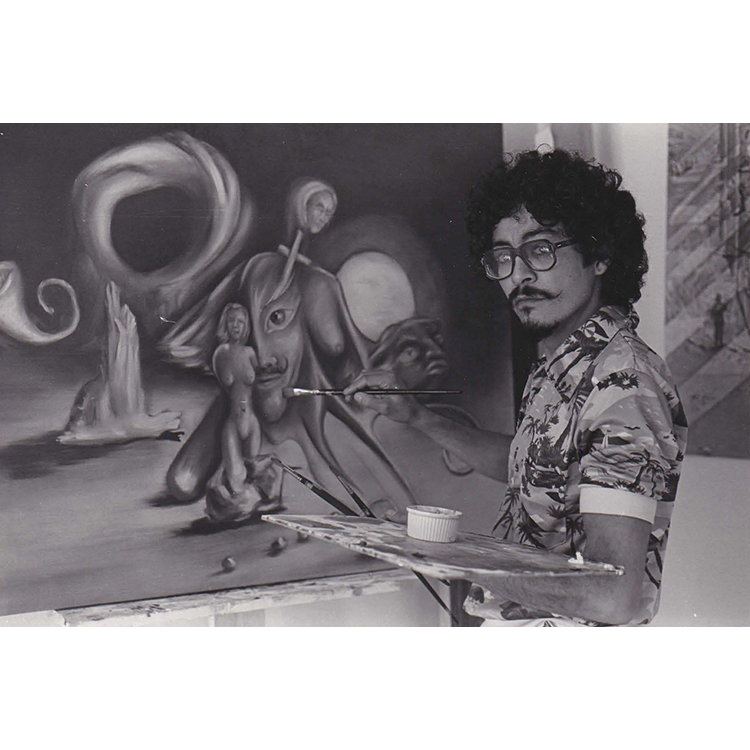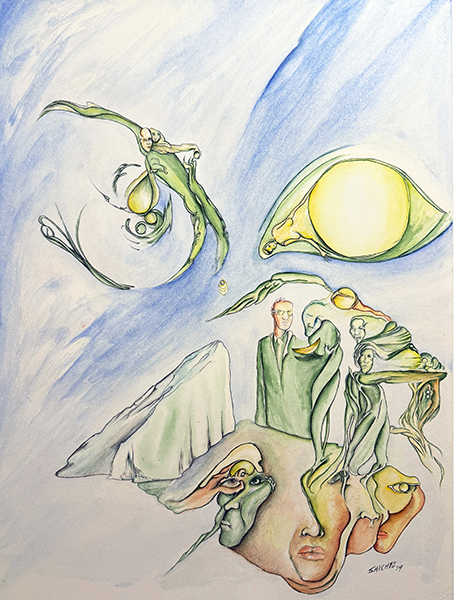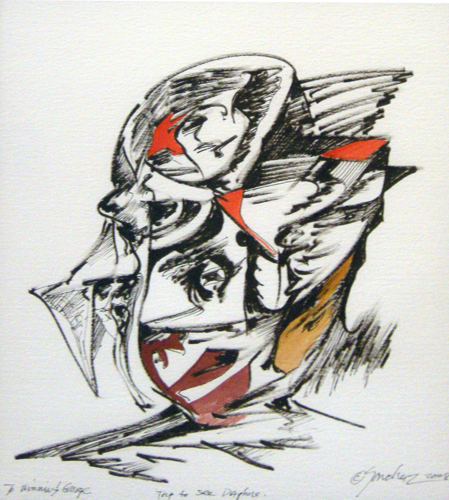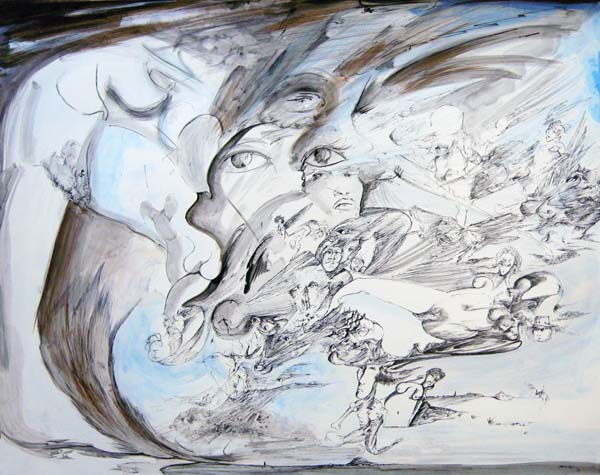Joseph Sanchez
Joseph Sanchez - Artist Biography
Born in Trinidad, Colorado to Pueblo, Spanish, and German parents, Joseph Marcus Sánchez was raised in Whiteriver, Arizona on the White Mountain Apache Reservation. In 1966, he graduated from Alchesay High School in Whiteriver, with the intent to join the priesthood. This was not the right fit, and he returned home to the White Mountains. Sadly, his mother became ill and died unexpectedly. Soon after, in 1968 he joined the United States Marine Corps and was stationed at the El Toro UCMC Base in California, where he trained soldiers drafted for the Vietnam War. His personal surrealist style began to formalize during these years as a member of United States Marine Corps with a drawing on newsprint called the Unconsummated Rape of Mongo.
Sánchez lived in Canada from the early to mid-1970s, and was a founding member of the "Professional Native Indian Artists, Incorporated”, otherwise known as the Indian Group of Seven. In Winnipeg he met Daphne Odjig, who had opened up the Warehouse Gallery in the early 1970s (now the Wahsa Gallery). In 1971, Sánchez showed Odjig a second version of the "Unconsummated Rape of Mongo," which she purchased and used to create an offset print, starting the career that continues today.
It was with Odjig, Alex Janvier, Norval Morrisseau, Jackson Beardy, Eddy Cobiness, and Carl Ray, that Sánchez collectively created the PNAI, Inc. in November of 1973, which was officially incorporated in February of 1974. Although more than 50 artists had been invited to participate, it was only these seven that answered the call to come to Winnipeg. Solo and with the group, he has exhibited in Canada, Europe, and the United States. It was during this time, he was named by the Ojibwa.
In 1974, Sánchez was commissioned to create the painting "The Virgin of Light" to be given as the Juno Award for Multiculturalism in Music. The same year he was measured and photographed with the painting for the Toronto Wax Museum. Also that year, Sánchez was commissioned to create “Fertility Totem,” a nine-foot sculpture made of Manitoba cedar, which was installed in the Franco-Manitoban Center in St. Boniface, Manitoba, and created for the Winnipeg Centennial.
Sánchez returned to the United States in 1976 and, meeting new artists, formed three collectives near Phoenix, the Movimiento Artistic del Rio Salado (M.A.R.S.), Azoma, and Ariztlan, helping lead Chicano artists to collaborate and exhibit together. In addition he helped create the National Association of Artist Organizations (NAAO) to benefit American artists on a national level. With this activist attitude, Sánchez developed exhibitions, changed museums, and created artist in residence programs for schools, with a focus being on sharing these experiences with the Native American community, especially the youth.
Sánchez continued to paint, perform, and develop art workshops for youth during the 1980s and 1990s, while developing his career as a curator, while honing his craft. Joseph opened a studio on historic Cattletrack Road, where he had Fritz Scholder and Phillip C. Curtis as neighbors. He maintained this studio for 22 years, firmly ensconcing him in the Scottsdale arts scene as a creator as well as an art professional.
In 1990, Sánchez visited Paris, which sparked an abundance of work. Yet, despite occasional exhibitions, Sánchez's energy was mostly spent supporting the careers of fellow artists. It was during this time that he shared a second studio with Jim Covarrubias in an old church in downtown Phoenix.
In the 2000s, with his move to Santa Fe, New Mexico, Sánchez's work shifted in tone and color, adapting to the new landscape. With a new studio, Sánchez returned to large-scale works like those of the early 1990s, some measuring as much as 15 ft tall. Also returning to drawing more frequently, the quality of work produced in the Santa Fe studio shows his long time dedication to craft and technique. In 2006, his work and career was recognized by Bill Richardson, Governor of New Mexico, at the New Mexico Governor’s Awards for the Arts where Sánchez received the Allan Houser Memorial Award for “Artistic Excellence and Community Involvement,” and for being an “Activist for Native American and Aboriginal Arts.”
Selected Exihbitions
Sacred Fire and Water Spirits, El Zaguan, The Historic Santa Fe Foundation, Santa
Fe, New Mexico, June 7, 2019 - June 28, 2019
7 Professional Native Indian Artists, Inc., Art Gallery of Alberta, Edmonton, Alberta, March 31, 2016 - June 5, 2016
7 Professional Native Indian Artists, Inc., Art Gallery of Winsor, Windsor, Ontario, October 2, 2015 - January 17, 2016
7 Professional Native Indian Artists, Inc., McMichael Collection, Kleinburg, Ontario, May 2016 - August 2016
7 Professional Native Indian Artists, Inc., Kelowna Art Gallery, Kelowna, British Columbia, October 2014 - January 2015
7 Professional Native Indian Artists, Inc., Winnipeg Art Gallery, Winnipeg, Manitoba, May 9, 2014 – August 2014
7 Professional Native Indian Artists, Inc., MacKenzie Art Gallery, Regina, Saskatchewan, September 2013 – January 2014
Grandmothers and Angels, Bearclaw Gallery, Edmonton, Alberta, 2012
Spirits of the Earth, West Valley Art Museum, Sun City, Arizona 2004
Angels of Light / Angels of Desire, MCM Gallery, Scottsdale, Arizona, 1999
Angels of Light / Angels of Desire, Cattletrack Studios, Scottsdale, Arizona ,1998
Angels of Desire, Glendale Community College, Glendale, Arizona, 1994
La Familia Sanchez-Shaman Landscapes, Mars Gallery, Phoenix, Arizona, 1985
Ghost Dance, Durfee Gallery, Scottsdale, Arizona. 1985
Ghost Dance, University of Arizona, Tucson, Arizona. 1984
Ghost Dance, Scottsdale Community College, Scottsdale, Arizona, 1982
Ghost Dance, Austin Gallery, Scottsdale, Arizona. 1982
Ghost Dance, West Coast Gallery, Newport Beach, California. 1981
Desert Lunch and other Paintings, Scottsdale Public Library, Scottsdale, Arizona, 1978
Recent Works by Sanchez, Warehouse Gallery, Winnipeg, Manitoba, December, 1975
Drawings, Brackendale Art Gallery, Brackendale, British Columbia, 1972
Selected Permanent Collections:
Aboriginal Affairs and Northern Development Canada, ON
Canadian Museum of History, QC
Heard Museum, AZ
Institute of American Indian Arts, New Mexico
MacKenzie Art Gallery, SK
Artist Specialization: Mainly self-taught, Sanchez is known for his “spiritual surrealist” style, which the artist describes as “sensual and dreamlike, provocative and thought-inducing.” Sanchez credits meeting Daphne Odjig in 1971 as the genesis of his artistic career. Sanchez was living outside of Manitoba in a small town named Richer. Odjig recognized the young artist’s talent, and published an offset print based on his work.





